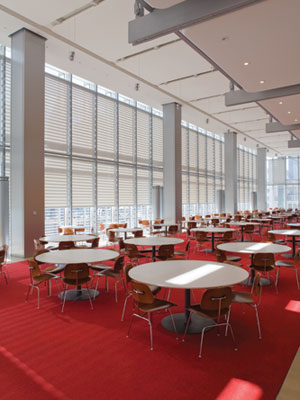Automated Shading and Light Systems
Daylighting Goal #1: Maximize Daylight, Control Glare
In 2013, designing for daylighting has become increasingly standard. More and more green building initiatives are incorporating language that defines the minimum amount of daylight that should be incorporated into a space and stipulates that some level of glare control is necessary. The preeminent green building rating system in the United States, the Leadership in Energy and Environmental Design (LEED) 2009 New Construction contains credit 8.1 Daylight and Views—Daylight which requires that specific daylighting levels be satisfied in 75 percent of regularly occupied spaces and mandates the inclusion of glare control devices.
Similar recommendations are finding their way into local guidelines and international rating systems like the Buildings Research Establishment Environmental Assessment Method (BREEAM™). Even the federal government is getting on-board with daylight in the workspace. The guidelines for High-Performance Sustainable Buildings (HPSB) as defined by the federal government require that federal buildings achieve a minimum daylight factor in 75 percent of all spaces occupied for critical visual tasks and provide glare control.
The Daylight Advantage
One impetus for the growing popularity of daylighting in design is the scientific validation that daylighting is both good for business and good for people. A significant body of work has been amassed over the last 40 years extolling the virtues of daylight in the workspace. Providing building occupants with a visual connection to the outdoors has been proven time and time again to improve morale, motivation, mental functioning, and maintain circadian rhythm. Documented increases in productivity and reductions in absenteeism are just two of the reasons why a daylit workplace works harder.
 |
Daylighting in the workplace can measurably improve productivity, employee outlook and feelings, resulting in reduced absenteeism. Photo courtesy of PDK Commercial Photographers, Ltd. DBA Bernstein Associates |
The Direct Sunlight Threat
However, not all daylight is created equal. The soft, diffuse daylight that fills the sky on a cloudy day has very different properties than the intense direct sunlight that seems to stream straight from the sun into a building. The intensity of direct sunlight can create glare and solar heat gain, ultimately causing discomfort and distraction for the people inside. So while bringing diffuse daylight into a workspace improves productivity, direct sunlight may destroy it and should be excluded to the greatest degree possible.
Causing glare in the office. As more and more daylight is being incorporated into the workspace, the threat of glare becomes more pressing and the use of glare control mandatory. People perceive the brightness of an object in terms of its contrast with surrounding objects. Car headlights on a sunny day are barely noticeable. The same car headlights on a dark stretch of highway can appear so radiant they are uncomfortable to look at for any period of time. Glare occurs when a light source or the reflection of a light source is significantly brighter (generally more than three times brighter) than the ambient light surrounding it, causing visual discomfort.
The visual discomfort is a result of the human eye being ill-equipped to deal with glare. The eye is capable of increasing or decreasing its overall sensitivity to light to function in both bright and dark settings. Unfortunately, the adjustment in sensitivity is uniform across the eye, making it impossible for the eye to compensate for hot spots that may exist in the visual field. If the eye's sensitivity is decreased to focus on the brightest object, the surrounding objects are too lowly lit to be seen clearly. If the eye's sensitivity is increased to read a dimly lit object, brighter objects in the visual field become glaring.









